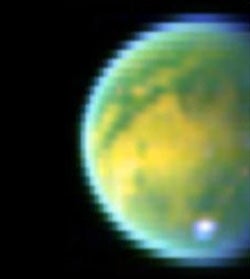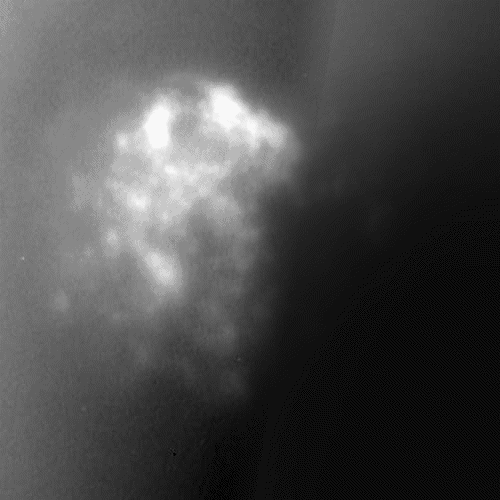The Cassini-Huygens spacecraft has only just arrived in orbit around Saturn, but its first results have already thrilled and puzzled planetary scientists. High on the spacecraft’s list of targets is the planet-sized, smog-shrouded moon named Titan. Early on Friday, Cassini swept within 210,600 miles (339,000 kilometers) of Titan, giving scientists their first clear look at the giant moon.
“Although the initial images appear bland and hard to interpret, we’re happy to report that, with a combination of instruments, we have indeed seen Titan’s surface with unprecedented clarity,” says Dennis Matson, Cassini project scientist for NASA’s Jet Propulsion Laboratory (JPL) in Pasadena, California. Titan’s dense atmosphere is opaque, but the spacecraft captured some surface details by observing the moon with infrared wavelengths that cut through the haze.
Cassini’s visible and infrared mapping spectrometer recorded Titan’s mineral and chemical features, revealing a variety of materials in the south and a large, circular feature — possibly an impact crater — in the north. “At some wavelengths, we see dark regions of relatively pure water ice and brighter regions with a much higher amount of non-ice materials, such as simple hydrocarbons,” says Kevin Baines, another member of the Cassini science team. A methane cloud visible near the south pole appears to be made of particles much larger than the moon’s typical haze particles, hinting at a dynamically active atmosphere.
In some wavelengths, Cassini’s camera also penetrates Titan’s haze. “We’re seeing a totally alien surface,” said Elizabeth Turtle of the University of Arizona, Tucson. “There are linear features, circular features, curvilinear features. These suggest geologic activity on Titan, but we really don’t know how to interpret them yet. We’ve got some exciting work cut out for us.”
The study of Titan, Saturn’s largest moon, is one of the major goals of the Cassini-Huygens mission, a joint project of NASA and the European and Italian Space Agencies. Over the next four years, the orbiter will execute 45 Titan flybys, many of which will be close enough to permit high-resolution mapping of the moon’s surface with an imaging radar instrument. In January 2005, the Huygens probe that is now attached to Cassini will descend through Titan’s atmosphere to the surface.











